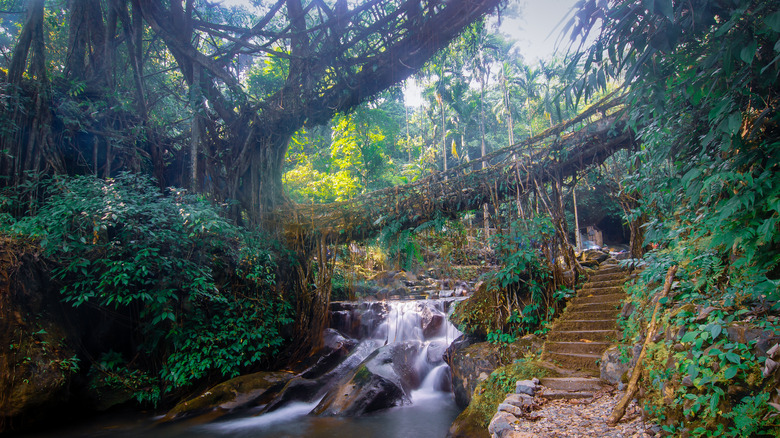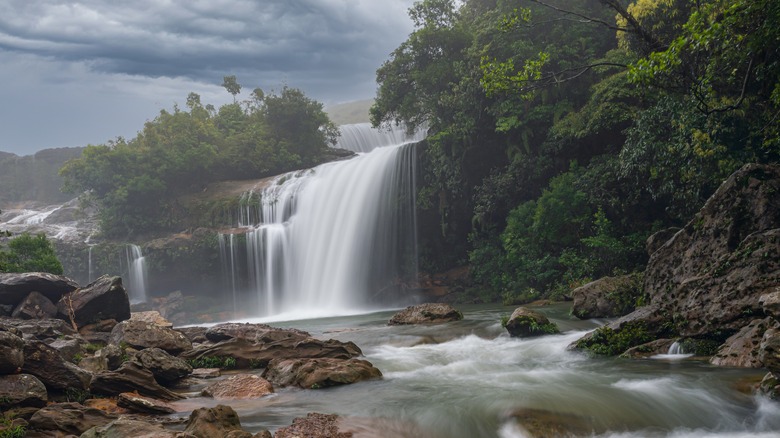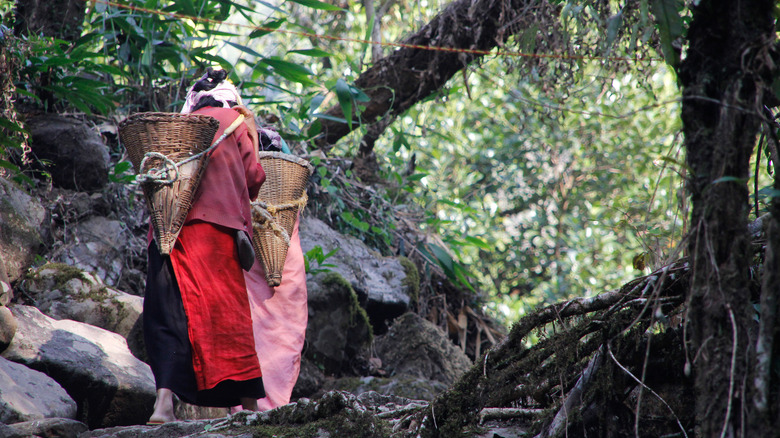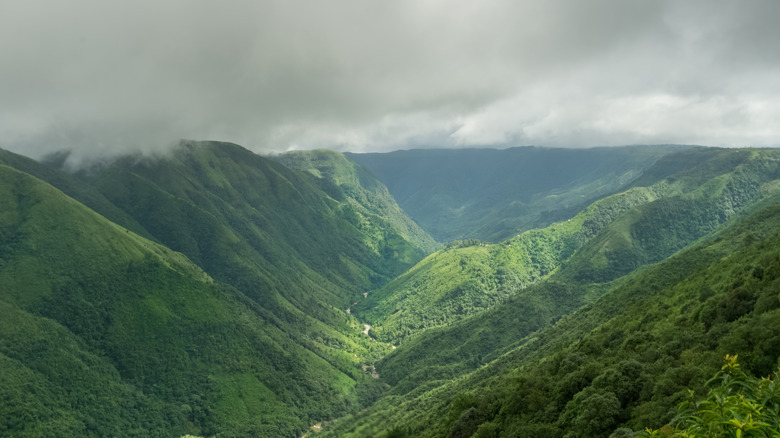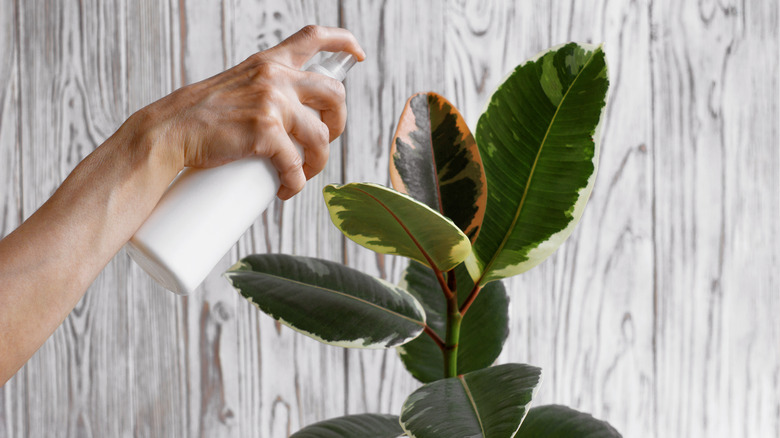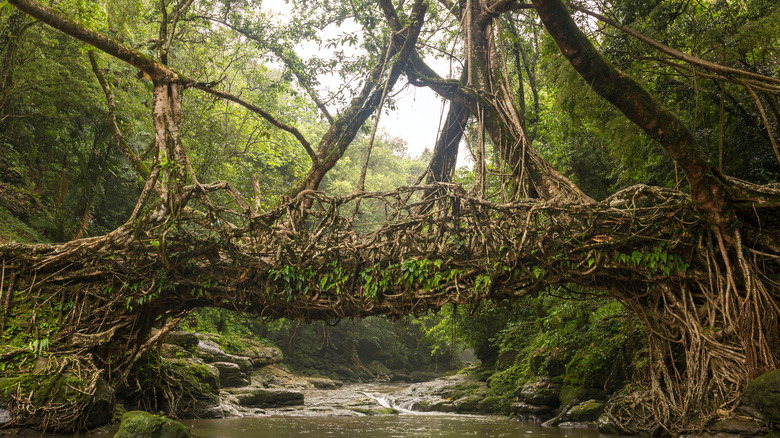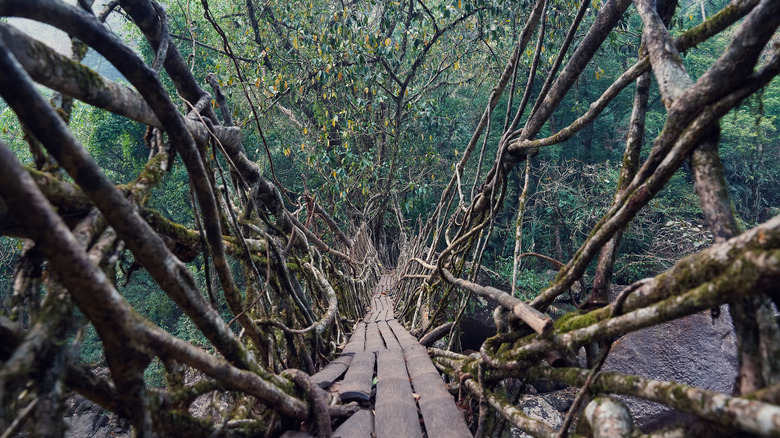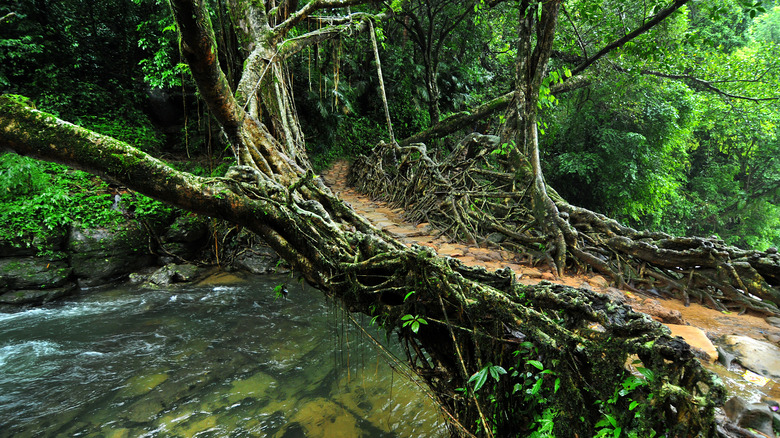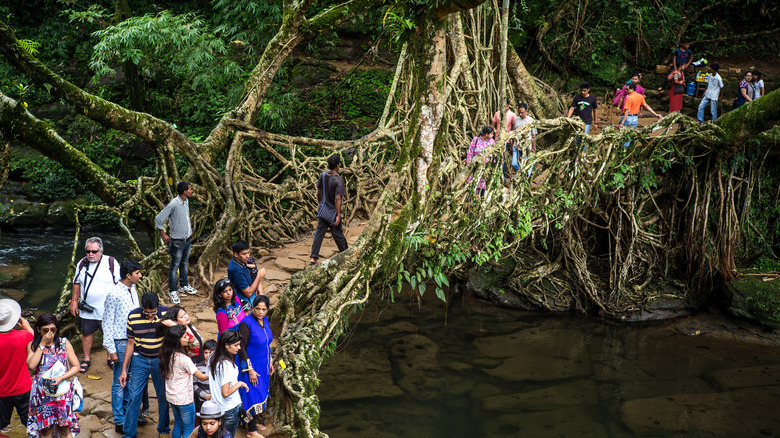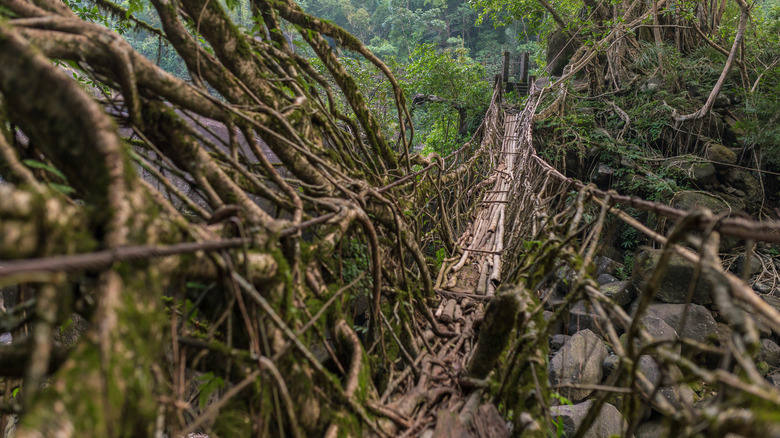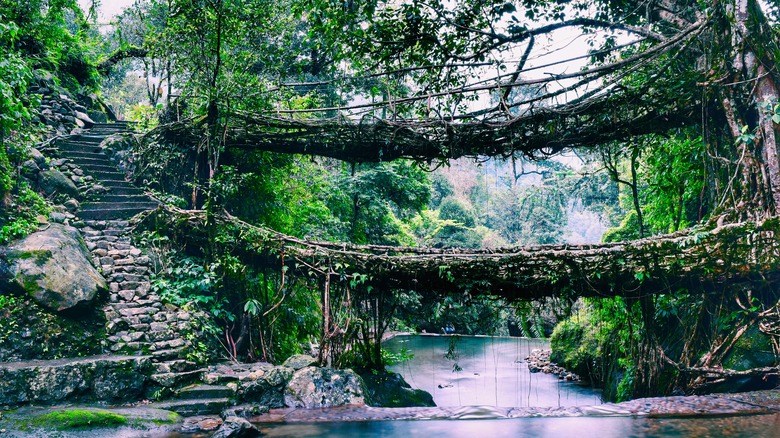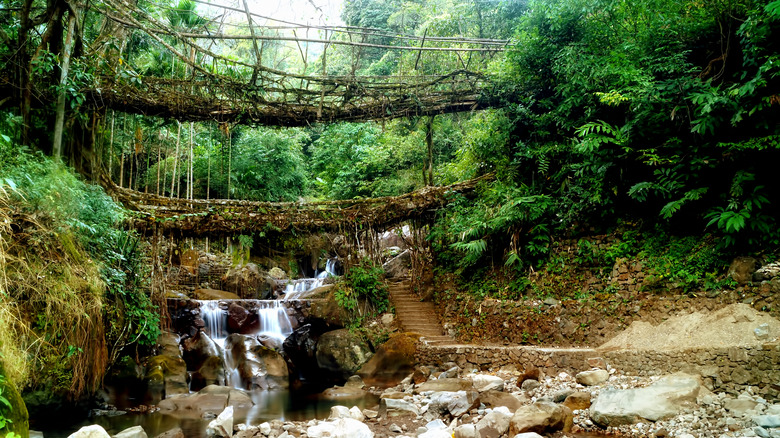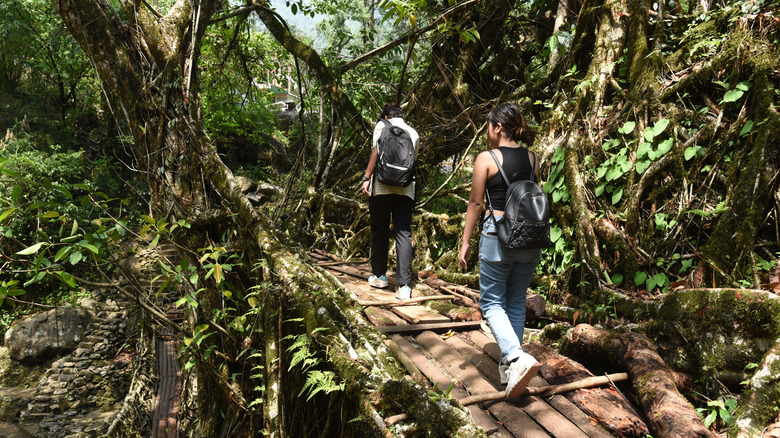The Truth About India's Living Bridges
Imagine, if you would, traveling on a path through a rain-drenched mountain forest scarred with twisted ravines and gushing with white water. There are hardly any roads to speak of. Then as you twist and turn through a forest path, your way is stopped by a gorge. Fortunately there is a bridge across the chasm. But instead of metal girders, suspension beams, or even the concrete span you might expect, this bridge seems to grow out of the earth itself. And that is because it does. The scene is wild, and visions of elven forest kingdoms worthy of J.R.R. Tolkien may come to mind.
But this is no fantasy. In a remote, rainy corner of India, there are a number of these living root bridges, called "jingkieng jri." These serve as a traditional and far superior means of infrastructure for this extreme region than anything that can be constructed by human hands. These bridges, which have only become widely publicly known in recent years, are also a model of green architecture and ecology. 72 of these marvels are also on the cusp of becoming a UNESCO World Heritage Site. Let's take a closer look at the truth about these astounding living bridges. So put on your hiking boots, take an umbrella, and let's travel to Meghalaya, India.
They are located in one of the wettest places in the world
Meghalaya, India, is one of the remotest and wettest places in the world. According to National Geographic, this rugged region within the Indian panhandle on the border of Bangladesh receives 40 feet of rainfall yearly. To compare, a wet city like Seattle gets just under 40 inches per year.
Why does Meghalaya get 12 times the rain of Seattle? World Atlas explains that the mountainous terrain acts like a funnel that squeezes the moist monsoon air that whips over the floodplains of Bangladesh and into the region. Then when that moist air hits the Khasi hills, it rises. Then it cools and condenses into epic amounts of rain. NPR reports that Meghalaya even translates to "abode of the clouds."
This amount of precipitation, as you may expect, causes a variety of problems. The Atlantic, for example, points out that, when outdoors, people often wear full body umbrellas made of banana leaves and bamboo called knups. Another more substantial problem is that any construction is subject to intensive water infiltration. Wood, concrete, and metal bridges are expensive and subject to deterioration or being swept away in the frequent floods. But functional bridges in Meghalaya are sorely needed because of the multiple waterways that need to be traversed. As a result, the people who live there have learned to live with nature and grow their living root bridges.
They are built by the Khasi and Jaintias
The people who build the jingkieng jri are the Khasi and Jaintias (via The Economic Times). According to Britannica, these two related tribes are thought to be the descendants of Mongolians who migrated into the region, although the BBC places them as being the descendants of a southeast Asian people from Burma. Perhaps one of the most unique aspects of Khasi and Jaintias society, aside from their bridges, is that they are matrilineal cultures. The BBC reports that descent is accounted for through the female line. Among the Khasi, this is demonstrated by how babies are given the surname of the mother and how, traditionally, a husband moves into his bride's family home. Even inheritance rules are shifted toward women with the youngest daughters receiving family property. As a result, women take a more dominant role in society.
These types of matriarchal societies are rare. According to Khasi folklore, their culture developed as men went to fight and die in wars on the floodplains. The resulting decline in the male population caused Khasi women to find new husbands who often would have different children with different husbands. To avoid the stigma of being called illegitimate, the culture changed where people adopted the maternal surname. Khasi women could speak and act freely, and the birth of a daughter is celebrated as much as the birth of a son.
The geography is rugged and remote, but the Khasi have adapted to it
Aside from the rainfall, the natural topography of Meghalaya is hilly and extremely rugged. Composed of foothills from the Himalayas, two ranges, the Khasi and the Garo, create a wild land which is difficult to transverse (via NPR). However, a living can be made. The Khasi are typically farmers who also fish, ferment rice beer, or distill spirits. Most live in bamboo houses which are elevated to be above water.
Even though Meghalaya receives an epic amount of rainfall it is seasonal. The dry season is one of farming and preparation for the rainy season. The rainy season, which begins in June and lasts till the autumn, sees most people seeking shelter indoors. Nowadays, the people of Meghalaya have electricity and access to mobile technologies, but it is still a time of sitting around and telling stories. In such a situation, the villages of Meghalaya are isolated from one another, without proper roads. To connect these people, paths have been made through the hilly forests. Villagers must negotiate these and cross, especially during the rainy season, raging rivers. Thus, living root bridges were born.
The bridges are made from house plants
The jingkieng jri of Meghalaya are made from Ficus elastica, which is, according to NC State, the ubiquitous rubber plant or rubber tree. It is one of the most common trees in India and a very common houseplant. While rubber plants in the home grow only as large as the pot, in the wild, the rubber tree can grow to over 196 feet tall and lives comfortably among the boulders of riverbanks or within the flood itself. As the tree grows, it issues aerial roots from mid-trunk. These sturdy roots, Atlas Obscura describes, are the key to living-root-bridge building — or growing, to put it more accurately.
At some point, the Khasi and Jaintias had an idea and saw an opportunity to use these large aerial roots as bridges. National Geographic reports that the general idea is to manipulate the large roots by training them so that they are directed over and intertwine with roots from a neighboring tree. It is sort of like bonsai, but at a grand scale. The process is rather straightforward, requiring some scaffolding, bamboo stalks, and lots of patience. The bridges are constructed over the course of decades, but when they are complete, they look even more natural than, say, something out of an Ewok village.
They may be natural, but they are grown deliberately
These bridges, while appearing incredibly natural are, in fact, built in a very deliberate way. NPR describes one type of process. Saplings are selected from within the forest and replanted along riverbanks that need a crossing. For over a decade, the saplings grow until they are large enough to shoot out aerial roots. At that point, the people work to train the roots over the river by building a scaffolding which also works as a temporary crossing. After years of coaxing and growing the two sets of roots finally meet in the middle. These are knitted which then over time merge through a process called anastomosis. As the tree ages more roots are grown which are then used to strengthen the bridge further. Eventually, the roots are strong enough to support pedestrians on their own and the scaffolding is removed or simply rots away. This is but one way to build these bridges. Atlas Obscura reports that bridges have been built using a simple method of pushing and pulling roots until they merge across a river.
In their growth, the living root bridges are the opposite of the construction of a modern bridge. The IABSE conference notes that building a traditional bridge often entails destroying the surrounding environment. In growing a jingkieng jri, the environment is, in fact, enhanced.
The details of a single one are very elaborate
What is really incredible about these bridges is, as Nature points out, that they are built without any sort of modern engineering, design, or forethought. The process itself is an organic one as roots, which in the wild hang vertically, are trained horizontally. Struts are woven from the roots, and even living ladders are constructed to help people along the journeys — mostly across rivers but sometimes just to farmlands. Dozens of singular roots (or more) can form an entire crossing.
For some bridges, the Khasi and Jainita install handrails or stones that help guide a traveler across the bridge. These may be the only nonliving elements of a bridge. Because the bridges change over time as roots grow and develop, none can be really analyzed mechanically in any standardized way. Perhaps this is the beauty of the jingkieng jri since they are outside the element of normal human industry and artifice.
They live for centuries
Some of the world's most prominent man-made bridges seemed to be built to last. World Atlas describes how a stone slab bridge in Izmir, Turkey, dates to 850 B.C. And there are some more modern constructions which have lasted such as the Union Chain Bridge in the U.K. which, according to Guinness World Records, is over two centuries old. However, most are not built with that kind of durability in mind. Infrastructure Report Card states that most bridges in the United States have about a 50 year life span.
This is what makes the living bridges of India so unique. While they often take years to build, when mature, they can last centuries. Nature surveyed a swath of the root bridges and relying oral data confirmed that some were several centuries old. One of the oldest is "Nongbareh 1" which has been recorded in the database of the Living Root Bridge Project as being "very ancient," and Nature places it at over 400 years. The root bridges will last as long as the trees remain healthy. Nongbareh 1, for example, has a strong root system though the tree had been damaged some time ago due to latex extraction, and even though this practice was banned some time ago, the bridge's health is deteriorating.
They grow stronger with age
One unique characteristic of these living bridges is that the roots are incredibly strong with considerable tensile strength. The key to this strength and stability, according to Nature, is inosculation, a term which refers to the phenomena of how trees can grow into one another. This as a whole creates a sturdy and enduring platform. Atlas Obscura points out that some can hold up to 50 people at a time. And if a tree is still growing and given appropriate nutrients, they invariably become stronger over the years as new roots grow to reinforce the original roots (which are also growing stronger). The IABSE conference points out that in many ways, the redundancy of the living root bridges makes them more flexible in the face of sudden changes in conditions than traditional artificial bridges.
However, despite their strength there is a danger. These bridges have come to the world's attention, and it has pushed to endanger them. NPR points out that bridges, which were grown for sparse pedestrian traffic now can see hundreds of people during the rainy season. While certainly the tourist dollars have enriched the local economy, they are beginning to stress and endanger the trees.
Maintenance is required more for their early years
All bridges require maintenance, but unlike artificial bridges, the jingkieng jri seem to require more frontend maintenance during their early growth than in their maturity. NPR points out how when a living bridge is going, the people tending to it will spend a considerable amount of time bringing in new roots to build — or construct — the supplementary structures about it. Trees which are young and long are often supplemented with bamboo. This eventually disintegrates as the roots flourish. People also see to the health of the tree. One example of this is that as a tree grows, builders will put leaves into the gaps which then decompose, providing nutrients to the root system.
As the bridge ages, regular types of maintenance are carried out by individuals, families, or villages. It depends on the size and use of the bridge. These types of maintenance tasks are described by Nature to include pruning, tying up roots, and removing mosses or parasitic plants. They also ensure that pathway stones and soil are laid properly on the bridge for safer crossings. The IABSE conference notes the obvious economic advantage of the root bridges. Unlike artificial bridges, the maintenance costs of a living root bridge are quite minimal.
They can take different shapes
Because of the shifting terrain and growing conditions, each of the bridges is unique, and they all have different shapes. One of the longest, and probably oldest, of these bridges at over 164 feet in length (per Conde Nast Traveler) is located in the village of Rangthylliang. Another long bridge, as noted by the IABSE conference, is located at Mawkyrnot and extends some 250 feet. But perhaps the most famous of the living bridges is the one located in Nongriat which is a double-decker bridge. The book "Curiously Wandering" details a visit to Nongriat where the author calls the bridge, "not unique but astonishing." To add to the surreal feel of the scene, this bridge also features a nearby waterfall and water pool.
When considering the qualities of the bridges, not to mention the patient effort that went into building them, it is little wonder that they were included in a list of tentative UNESCO World Heritage sites in 2022. In their consideration, UNESCO states, "Each Living Root Structure reveals a distinct ethno-botanical journey rooted in profound culture- nature reciprocity and synthesis."
They enhance biodiversity
The jingkieng jri — aside from being astonishing spectacles of human and nature working in harmony — also greatly benefit the biodiversity of Meghalaya. Many forms of fauna and flora benefit from the living root bridges. The BBC points out that ficus elastica is a keystone plant species. They are uniquely endowed to survive in rain-drenched Meghalaya and serve as a harbor to insect pollinators, small mammals like squirrels, and other mosses. Using the tree as a means of connecting different areas also provides a natural passage for wildlife to travel from one area to another. Clouded leopards and bark deer are known to use the bridges as they pass from one area of the forests to another.
This only serves to demonstrate how the living root bridges just serve to bolster the ecosystem. A Meghalaya native and scientist, Salvador Lyngdoh, was interviewed by the BBC concerning the benefits of the bridges to the region's ecology. He commented to the BBC that while man-made bridges can bear greater weight, "root bridges are much more useful to a large sphere of natural species than the modern bridges we have. The living root bridge is a mosaic that's embedded within the forest. Species do not differentiate between the bridge and natural forest."
The bridges are a model of sustainability
The jingkieng jri are a model of sustainability and truly an exemplar of green architecture. In a region which has some of the most extreme conditions in the world, the Khasi and Jaintias have devised a means of working with nature to create something that works better than anything that can be made artificially. What is more, these structures are a boon to the local ecosystem. The IABSE conference published research on these bridges and lists their benefits to include not only the practical human benefits of the bridges, but also how they help with carbon sequestration, improve soil, water, and air, and perform a key role in their ecosystem.
The researchers wrote that the living root bridges, "offer an extraordinary model for long-term socio-ecological resilience." They recommend figuring ways to further incorporate this unique technique and expand it so that it one day may be able to handle vehicular traffic. This has, in turn, brought to the world's attention the creative techniques and ecologically friendly means by which indigenous people have lived for eons. In the end, the truth about India's living bridges is that they are something industrialized society should aspire to.
